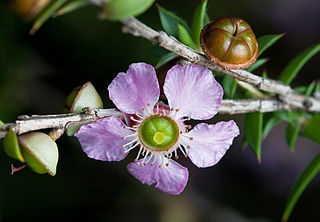
Leptospermum is a genus of shrubs and small trees in the myrtle family Myrtaceae commonly known as tea trees, although this name is sometimes also used for some species of Melaleuca. Most species are endemic to Australia, with the greatest diversity in the south of the continent, but some are native to other parts of the world, including New Zealand and Southeast Asia. Leptospermums all have five conspicuous petals and five groups of stamens which alternate with the petals. There is a single style in the centre of the flower and the fruit is a woody capsule.

The Hunter Region, also commonly known as the Hunter Valley or Newcastle Region, is a region of New South Wales, Australia, extending from approximately 120 km (75 mi) to 310 km (193 mi) north of Sydney. It contains the Hunter River and its tributaries with highland areas to the north and south. Situated at the northern end of the Sydney Basin bioregion, the Hunter Valley is one of the largest river valleys on the NSW coast, and is most commonly known for its wineries and coal industry.

Desmodium is a genus of plants in the legume family Fabaceae, sometimes called tick-trefoil, tick clover, hitch hikers or beggar lice. There are dozens of species and the delimitation of the genus has shifted much over time.

Grona triflora, known as creeping tick trefoil or three-flower beggarweed, is a plant in the family Fabaceae. It is native to tropical regions around the globe and introduced to subtropical regions including the southern United States.

Desmodium gangeticum is commonly known by the name salparni. It can be found throughout most parts of India and Himalayas.

Olearia phlogopappa commonly known as the dusty daisy-bush or alpine daisy-bush is a species of flowering plant in the family Asteraceae that is commonly found in eastern New South Wales, Victoria and Tasmania. It is a small shrub with greyish-green foliage, daisy-like flowers in white, pink or mauve that can be seen from spring to late summer.

Hylodesmum is a genus of flowering plants in the family Fabaceae, sometimes called ticktrefoils or tick-trefoils. It is sometimes treated as part of Desmodium.
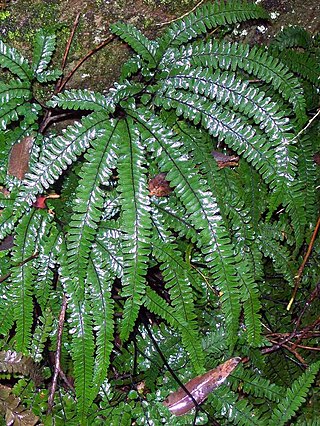
Adiantum hispidulum, commonly known as rough maidenhair fern or five-fingered jack, is a small fern in the family Pteridaceae of widespread distribution. It is found in Africa, Australia, Polynesia, Malesia, New Zealand and other Pacific Islands. Its fronds rise in clumps from rhizomes among rocks or in the soil in sheltered areas.

Stackhousia monogyna, commonly known as creamy stackhousia or creamy candles,is a flowering plant in the family Celastraceae. It is a small multi-stemmed plant with narrow leaves and terminal spikes of white, cream or yellow flowers. It is a widespread species found in all states of Australia but not the Northern Territory.
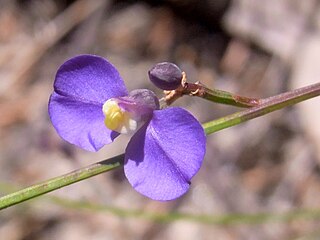
Comesperma sphaerocarpum, commonly known as the broom milkwort, is an Australian plant in the milkwort family. Inconspicuous unless in flower, it grows from 10 to 30 cm high. The stems are ridged and usually leafless, and arise from the plant's woody base. The rarely seen leaves are at the base of the shoot. They are thick in texture, and measure 8 mm long by 2 mm wide. This plant first appeared in scientific literature in Plantae Preissianae in 1846, authored by the German botanist Joachim Steetz.

Gastrodia sesamoides, commonly known as cinnamon bells or common potato orchid in Australia and as the pot-bellied orchid or cinnamon sticks in New Zealand, is a leafless, terrestrial saprophytic orchid in the family Orchidaceae. It has a thin, fleshy brown flowering stem and up to twenty five drooping, brownish, self-pollinating flowers that are white inside. Growing in a wide range of habitats, it is native to Australia and New Zealand.

Pedleya acanthoclada, commonly known as thorny pea, is the only species of flowering plant in the genus Pedleya of the family Fabaceae. It is a small shrub with pink or purplish flowers, and leaves in groups of three.
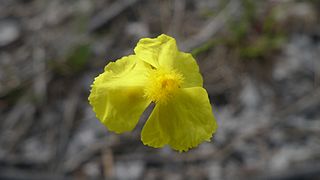
Xyris juncea, the dwarf yellow-eye found in northern and eastern Australia. A widespread plant seen in swampy areas. A tufted herb, growing up to 30 cm high. This is one of the many plants first published by Robert Brown with the type known as "(J.) v.v." Appearing in his Prodromus Florae Novae Hollandiae et Insulae Van Diemen in 1810. The specific epithet juncea is derived from Latin, meaning a resemblance to a sedge.
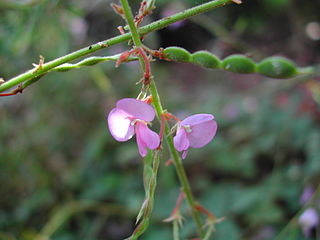
Desmodium rhytidophyllum is a small twining herb or trailing shrub in the family Fabaceae. A plant with rusty or felty hairs on all parts, found in eastern and northern Australia. Attractive pink flowers may form at any time of the year. The specific epithet rhytidophyllum is derived from Greek, describing the wrinkled leaves.

Stackhousia spathulata, the coast Stackhousia is a species of plant in the family Celastraceae. A widespread small plant, found in heath and dry sclerophyll forest in sandy areas, often near beaches or lagoons in southeastern Australia. Growing to 50 cm tall. The specific epithet refers to the spoon shaped leaves.

Calystegia marginata is a species of morning glory, found in eastern Australia and New Zealand. A hairless and vigorous perennial climbing plant, with twining stems. The habitat is moist gullies in sclerophyll forest and on rainforest margins, widespread on the coast and ranges of eastern Australia.This is one of the many plants first published by Robert Brown with the type known as "(J.) v.v." appearing in his Prodromus Florae Novae Hollandiae et Insulae Van Diemen in 1810. The specific epithet marginata is derived from Latin, probably referring to the habitat being the margins of rainforests.

Desmodium uncinatum, the silverleaf desmodium, is a species of flowering plant in the family Fabaceae, native to Latin America, and introduced as a fodder to various locales in Africa, India, New Guinea, Australia and Hawaii. Although chiefly a fodder, it can also be used for pasture, deferred feed, cut-and-carry, hay, ground cover, and mulch. It is considered invasive in Australia and Hawaii.

Pavona varians, also known by its common name corrugated coral, is a species from the genus Pavona. Pavona varians is a type of hermatypic coral commonly distributed across tropic environments. Distribution of the coral include the equatorial Indian and Pacific Ocean, and notably, not found in the Atlantic ocean. Pavona varians have also been found to be distributed as North as the sea of Japan, in the Red Sea, and islands off the Pacific coast of Columbia and Costa Rica. Pavona varians are typically found an average of 45 feet below water on vertical surfaces in turbid, nutrient rich, water. Specifically, Pavona varians are found between crevices of the reef crest habitats and back reef habitats, including lagoons.

The Southern Tablelands Temperate Grassland, formally Natural Temperate Grassland of the Southern Tablelands, is a temperate grassland community situated in the Southern Tablelands and Monaro region of New South Wales, extending into the Australian Capital Territory and the Victorian border. Listed as Endangered under the Environment Protection and Biodiversity Conservation Act 1999, the grassland is dominated by reasonably tall, dense to open tussock grasses.

The Lowland Grassy Woodland, or the Illawarra and South Coast Lowland Grassy Woodland is a grassland-savannah community mostly found in the South Coast region of New South Wales, Australia. Stretching from the southern parts of the Illawarra in the north to the South East Corner in the south, it is an endangered ecological community that lies in a rain shadow area.




















